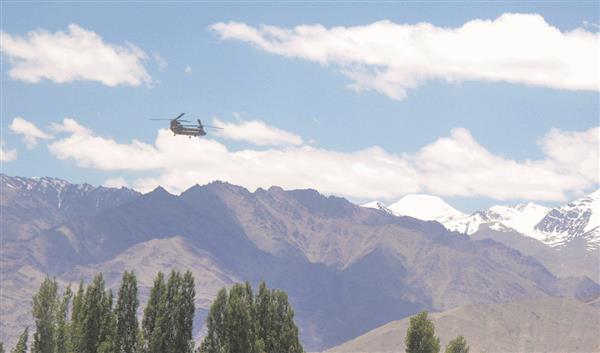
A Chinook flies over Leh valley amid tension with China.
Ajay Banerjee
Tribune News Service
New Delhi, July 1
India and China have yet again “agreed” to go in for a phased step-wise de-escalation, including pulling back fully armed troops and war-like equipment, from the Line of Actual Control (LAC) in Ladakh.
Read also: China to be kept off road projects
This is the third such attempt at “de-escalation”. Earlier two attempts to de-escalate did not work out, rather fresh military deployment was carried out by either side by adding troops and equipment like tanks, guns, radars, UAVs and fighter jets.
Rajnath, Naravane to visit Ladakh tomorrow
New Delhi: Defence Minister Rajnath Singh is scheduled to visit Ladakh on Friday to take stock of India’s military preparedness, sources said. To be accompanied by Chief of Army Staff Gen MM Naravane, it will be the defence minister’s first visit to Ladakh after the recent standoff. PTI
Sources in New Delhi said the meeting of the Lt General-level commanders at Chushul on Tuesday had ended late at night. “Both sides emphasised the need for an expeditious, phased and step-wise de-escalation as a priority,” the source said.
More meetings are expected both at the military and at the diplomatic level in future to arrive at mutually agreeable solution and to ensure peace and tranquillity along the LAC as per bilateral agreements and protocols, authorities in New Delhi said.
A source explained the need for “more meetings”, saying China is adamant on denying Indian troops patrolling rights east of ‘Finger 4’ in the north of Pangong Tso. Similar issues persist at a few other spots. The Area east of ‘Finger 4’ is also claimed by India and its troops regularly patrolled the area.
Earlier two similar attempts to resolve the standoff after the June 6 and June 22 meetings had come a cropper. On the night intervening June 15 and June 16, troops of both sides were involved in a deadly clash. After the June 22 meeting, there was a decision to maintain a physical distance of at least 3 km between troops, but that was disregarded.
Meanwhile, Chinese Foreign Ministry spokesperson Zhao Lijian at Wednesday’s press briefing in Beijing said: “The two sides continue working towards implementing the consensus reached at the two earlier rounds of commander-level talks and made progress in effective measures by frontline troops to disengage and de-escalate the situation. China welcomes that. We hope the Indian side will work with the Chinese side, keep up close communication through military and diplomatic channels, and ease the situation and reduce the temperature along the border.”
Global Times, the mouthpiece of the Communist Party in China, put the onus on “both sides” to respect historical facts and accommodate each other’s core concerns. In New Delhi, sources said Tuesday’s talks were in line with the agreement between External Affairs Minister and his Chinese counterpart during their conversation on June 17. The two sides had agreed that both sides would sincerely implement the disengagement understanding of June 6.
Join Whatsapp Channel of The Tribune for latest updates.



























